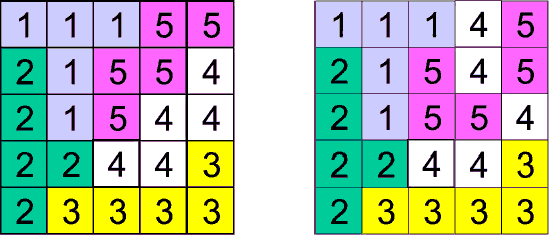当前你的浏览器版本过低,网站已在兼容模式下运行,兼容模式仅提供最小功能支持,网站样式可能显示不正常。
请尽快升级浏览器以体验网站在线编辑、在线运行等功能。
3194:Equidivisions
题目描述
An equidivision of an n × n square array of cells is a partition of the n2 cells in the array in exactly n sets, each one with n contiguous cells. Two cells are contiguous when they have a common side.
A good equidivision is composed of contiguous regions. The figures show a good and a wrong equidivision for a 5 × 5 square:

Note that in the second example the cells labeled with 4 describe three non-contiguous regions and cells labeled with 5 describe two non-contiguous regions. You must write a program that evaluates if an equidivision of the cells in a square array is good or not.
输入解释
It is understood that a cell in an n × n square array is denoted by a pair (i, j), with 1 ≤ i, j ≤ n. The input file contains several test cases. Each test case begins with a line indicating n, 0 < n < 100, the side of the square array to be partitioned. Next, there are n − 1 lines, each one corresponding to one partition of the cells of the square, with some non-negative integer numbers. Consecutive integers in a line are separated with a single blank character. A line of the form
a1a2a3a4…
means that cells denoted with the pairs (a1, a2), (a3, a4), … belong to one of the areas in the partition. The last area in the partition is defined by those cells not mentioned in the n − 1 given lines. If a case begins with n = 0 it means that there are no more cases to analyze.
输出解释
For each test case good must be printed if the equidivision is good, in other case, wrong must be printed. The answers for the different cases must preserve the order of the input.
输入样例
2 1 2 2 1 5 1 1 1 2 1 3 3 2 2 2 2 1 4 2 4 1 5 1 3 1 4 5 5 2 5 3 5 5 5 4 2 5 3 4 3 5 4 3 4 4 5 1 1 1 2 1 3 3 2 2 2 2 1 3 1 4 1 5 1 4 2 4 5 5 2 5 3 5 5 5 4 2 4 1 4 3 5 4 3 4 4 0
输出样例
wrong good wrong
最后修改于 2020-10-29T06:55:22+00:00 由爬虫自动更新
共提交 0 次
通过率 --%
| 时间上限 | 内存上限 |
| 1000 | 65536 |